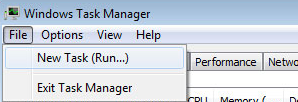Note
Access to this page requires authorization. You can try signing in or changing directories.
Access to this page requires authorization. You can try changing directories.
This article provides a solution to an issue where the file may start a different program when you run an .exe file in Windows 7.
Applies to: Windows 7 Service Pack 1
Original KB number: 950505
Symptoms
When you run an .exe file in Windows 7, the file may start a different program. Additionally, the icon for the .exe file may not appear as expected. You may also receive additional errors from the .exe file or from the program that starts.
Resolution
Important
This section, method, or task contains steps that tell you how to modify the registry. However, serious problems might occur if you modify the registry incorrectly. Therefore, make sure that you follow these steps carefully. For added protection, back up the registry before you modify it. Then, you can restore the registry if a problem occurs. For more information about how to back up and restore the registry, see How to back up and restore the registry in Windows.
To resolve this problem, reset the registry subkey for the file association of the .exe file back to the default setting. To do this, follow these steps:
To open the Task Manager, press CTRL + SHIFT + ESC.
Click File, press CTRL and click New Task (Run...) at the same time. A command prompt opens.

At the command prompt, type notepad, and then press ENTER.

Paste the following text into Notepad:
Windows Registry Editor Version 5.00 [-HKEY_CURRENT_USER\Software\Microsoft\Windows\CurrentVersion\Explorer\FileExts\.exe][HKEY_CURRENT_USER\Software\Microsoft\Windows\CurrentVersion\Explorer\FileExts\.exe][HKEY_CURRENT_USER\Software\Microsoft\Windows\CurrentVersion\Explorer\FileExts\.exe\OpenWithList][HKEY_CURRENT_USER\Software\Microsoft\Windows\CurrentVersion\Explorer\FileExts\.exe\OpenWithProgids] "exefile"=hex(0):On the File menu, click Save as.

Select All Files in the Save as type list, and then type Exe.reg in the File name box.
Select Unicode in the Encoding list. Save it and remember the file location.

Return to the Command Prompt window, type
REG IMPORT <filepath> Exe.reg, and then press ENTER.
Note
<filepath> is a placeholder which is to input your Exe.reg file location (for example, C:\Exe.reg).
Click Yes, and then click OK in response to the registry prompts.
Log off from your account. Then, log back on to your account.
Note
- You may have to restart the computer to restore the program icons to their original appearance.
- After the problem is resolved, delete the Exe.reg file so that it is not mistakenly added back to the registry at a later date.